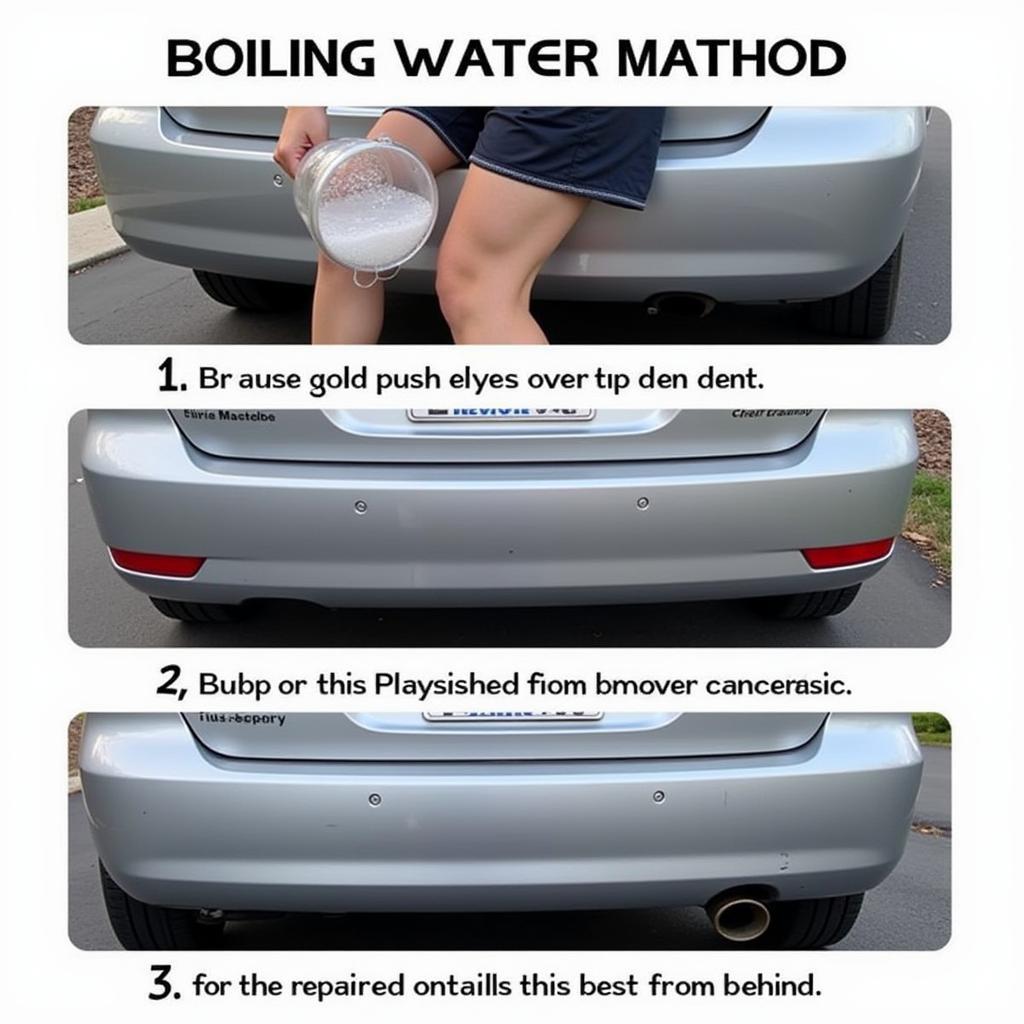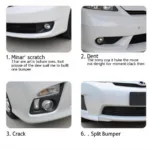Dents and dings are an unfortunate reality of car ownership. Knowing how do I repair a dent in a car bumper can save you a significant amount of money compared to professional repairs or replacements. This guide will walk you through several DIY methods, from simple fixes for minor dents to more involved repairs for deeper damage. We’ll cover the tools you’ll need, the steps involved, and offer professional tips to get the best results.
Assessing the Damage: Knowing Your Bumper
Before you begin any repair, it’s crucial to assess the damage to your bumper. Bumper materials vary—thermoplastic olefin (TPO), polyurethane (PU), and fiberglass-reinforced plastic (FRP) are common. Each material responds differently to repair techniques. A minor dent in a plastic bumper might pop out with a little heat, while a deeper dent or crack might require filling and sanding. Understanding the extent of the damage and your bumper material will determine the best repair method. Check behind the bumper for any hidden damage too. If you notice any significant structural damage, it’s best to consult a professional. Now you know how you asses the damage of a car bumper.
Simple Fixes for Minor Dents: The Boiling Water Method
For small, shallow dents in plastic bumpers, boiling water can work wonders. This method relies on the plasticity of the bumper material. Heat makes the plastic more pliable, allowing you to reshape it. Carefully pour boiling water over the dented area. Wearing gloves, reach behind the bumper and gently push the dent outwards. Repeat the process as necessary. This technique is often effective for minor cosmetic damage. Learn more about repairing a scratched bumper at repair scratched plastic car bumper.
Repairing Deeper Dents and Cracks: Filling and Sanding
Deeper dents and cracks require a more involved approach. You’ll need a plastic bumper repair kit, which typically includes a filler, hardener, sandpaper, and applicator. Clean the damaged area thoroughly and lightly sand it to create a better surface for adhesion. Mix the filler and hardener according to the kit’s instructions. Apply the filler to the dent, building it up slightly above the surrounding surface. Once the filler dries, sand it down until it’s flush with the bumper. You can also learn how to repair a scratched black plastic car bumper.
Painting and Finishing Touches: Blending the Repair
After sanding, clean the repaired area. If the damage is noticeable, you’ll need to apply primer and paint. Choose a paint that matches your car’s color. Apply several thin coats, allowing each coat to dry before applying the next. Finish with a clear coat to protect the paint and give it a glossy finish. This guide offers a cost breakdown for car bumper repair cost scratch.
Professional Tips for a Flawless Repair
- Cleanliness is key: A clean surface is essential for proper adhesion of filler and paint.
- Patience is a virtue: Allow ample drying time for filler, primer, and paint.
- Less is more: Apply filler and paint in thin coats to prevent cracking and ensure even coverage. If you need help with a scratch, learn how to repair a scratch on a car bumper.
“A common mistake DIYers make is rushing the process,” says automotive expert, Michael Davis. “Proper preparation and patience are crucial for achieving professional-looking results.”
Another expert, Sarah Chen, adds, “Don’t be afraid to practice on a scrap piece of plastic before working on your bumper. It’s a great way to get a feel for the materials and techniques.”
Conclusion: Repairing Your Car Bumper Successfully
Repairing a dent in a car bumper can be a satisfying DIY project. By understanding the different repair methods and following the steps carefully, you can save money and restore your bumper to its former glory. Remember to assess the damage, choose the appropriate method, and be patient throughout the process. How do I repair a dent in a car bumper? Now you know.
FAQ
- Can I repair a cracked bumper myself? Yes, minor cracks can often be repaired using a plastic bumper repair kit.
- What if the dent is too large for DIY repair? For extensive damage, consult a professional body shop.
- Do I need special tools for bumper repair? Basic tools like sandpaper, a heat gun or hairdryer, and a plastic spreader are often sufficient.
- Can I use any type of paint on my car bumper? Use automotive paint specifically designed for plastic bumpers.
- How long does the repair process take? The time varies depending on the extent of the damage, but most DIY repairs can be completed within a few hours.
- How much does a professional bumper repair cost? Costs can range from a few hundred to over a thousand dollars, depending on the severity of the damage and the type of vehicle.
- What if the dent won’t pop out with boiling water? You may need to try a different method, such as using a plunger or a heat gun, or opt for filling and sanding.
Common Bumper Dent Scenarios
- Parking lot bumps: These are often minor and can be addressed with the boiling water method.
- Backing into objects: Depending on the force of impact, these dents can range from minor to severe, potentially requiring filling and sanding or even professional repair.
- Collision damage: Significant collision damage often requires professional attention. For other scratch repairs, see how to repair a scratched plastic car bumper.
Further Reading and Resources
For more in-depth information on car repair and maintenance, check out our other helpful articles.
Need Assistance? Contact Us!
For personalized guidance and support with your car repair needs, reach out to our expert team 24/7. Contact us via WhatsApp: +1(641)206-8880 or Email: [email protected].


